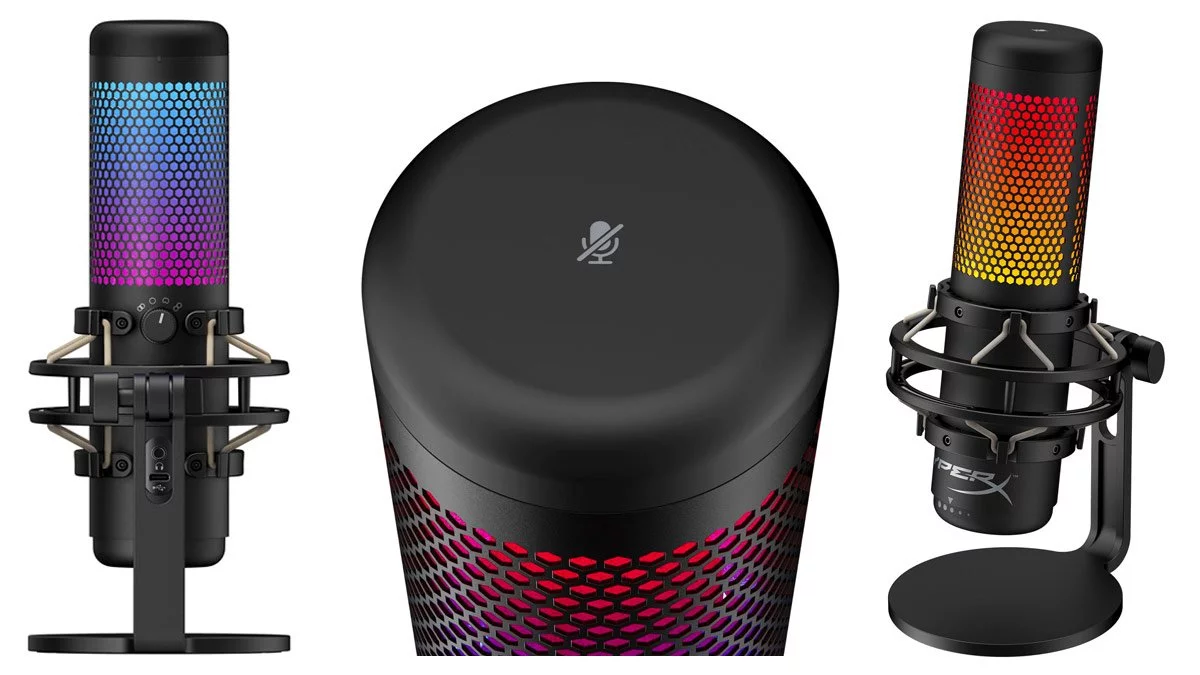A standalone USB microphone packed with features that looks good and sounds even better.
It isn’t just Microsoft enamoured by the X and S monikers this generation, as HyperX returns with the S version of its Quadcast standalone USB microphone. It follows the original S-less Quadcast, boasting a very similar feature set where it matters, and a serious splash of colour for those who want to broadcast, record or chat in style. As the name suggests, everything you need for a quality recording is included in the box, without any noticeable compromises for most users, and that is what makes the Quadcast S so enticing.
It’s a flashy mic, complete with a rainbow of colourful lights that brighten even the dullest of rooms – and certainly brought some colour to my freshly painted white, but still very bare, walls during recent episodes of Stevivor’s Friendly Fire Show. I’ve used it for the last three episodes at the time of publishing (episodes 182, 183 and 185), as well as a guest appearance on weekly Australian gaming show The Question Box.
It pulses with reds, purples , greens, yellows and blues by default, and is fully customisable with RGB colour – but don’t worry, if you want a versatile microphone that is as suitable for business Zoom calls as it is for after hours Discord banter, it can be disabled to regain the appearance of a classic broadcast microphone that has often anchored the desks of US talk shows. However, to do all that, you’ll need to use the HyperX NGenuity app. Muting the mic turns the lights off, but it would have been nice to have a button to toggle it on or off during use as well.
I’m no streamer, the primary market for the HyperX Quadcast S, but as a fortnightly podcaster, it features everything I’m looking for straight out of the box. A physical switch on the rear selects the polar pattern from stereo (instruments or vocals), omnidirectional (conference calls or shared mic recordings), cardioid (podcasts, streaming or instruments) or bidirectional (face-to-face interviews). I flicked the switch for a podcast, connected the USB cable and plonked it on my desk. That was the extent of my setup, I haven’t touched it otherwise, and it sounds fantastic.
Having moved house some months ago, with renovations on-going, the spare room remains neglected and far-removed from a dedicated recording space; the Quadcast S has done a fantastic job of covering for my lack of dedicated podcast zone, with no work required on my part. The built-in features, including an anti-shock mount and internal pop filter, continue the theme of plug-and-play without sacrificing features or requiring much setup. Diehard audiophiles may prefer to establish such add-ons themselves for maximum effect, but from where I’m sitting, the more built-in functionality the better.
Coming from other set-and-forget USB microphones, I was pleasantly surprised with the carefully curated physical controls on the Quadcast S that most similar microphones omit. There’s a dial on the bottom to easily adjust your gain levels, a headphone jack, and a touch sensitive mute button on the top to hide sneezes or opening a cheeky beer mid-recording. That’s far easier to access than muting the recording momentarily on my Mac or PC – I must remember to actually use it more often.
Such a convenient out-of-the-box microphone is never going to topple a fully decked out recording setup, but it comes mighty close, and for ease of use, it’s my ideal solution. My voice is crisp and strong, and the quality of the recording sounds great when played back across YouTube, Spotify, Apple Podcasts, Google Podcasts or your podcast app of choice.
The HyperX Quadcast S has a ticket price around AUD $270, while the original Quadcast is priced around AUD $200. The former injects some serious style, and while I haven’t used the latter, the specs suggest it’ll offer similar quality and might be better suited for those looking for a recording solution focused on audio-only. Either way, the HyperX Quadcast S is a stylish and versatile condenser microphone that’s a fantastic solution for plug-in and get started podcasting or video calls in my experience – and it looks the goods for streaming or trash talking during online gaming, if you’re more into that sort of thing.
 |
|
The good
|
The bad
|
The HyperX Quadcast S Standalone USB Microphone was reviewed using a promotional unit provided by the manufacturer and was tested on Windows and OS X. Click here to learn more about Stevivor’s scoring scale.
Product data
Supplied from hyperxgaming.com
| Power consumption | 5V 220mA (white light) |
| Sample/bit rate | 48kHz/16-bit |
| Element | Electret condenser microphone |
| Condenser type | Three 14mm condensers |
| Polar patterns | Stereo, Omnidirectional, Cardioid, Bidirectional |
| Frequency response | 20Hz–20kHz |
| Sensitivity | -36dB (1V/Pa at 1kHz) |
| Cable length | 3m |
| Weight | Microphone: 254g Shock mount and stand: 360g Total with USB cable: 710g |
| Lighting | RGB (16,777,216 colors) |
| Light effects | 2 zones2 |
| Connection type | USB-C to USB-A |
|
Headphone Output |
|
|---|---|
| Impedance | 32 Ω |
| Frequency response | de 20Hz à 20kHz |
| Maximum power output | 7mW |
| THD | ≤ 0.05% (1kHz/0dBFS) |
| SNR | ≥ 90dB (1kHZ, RL=∞) |
This article may contain affiliate links, meaning we could earn a small commission if you click-through and make a purchase. Stevivor is an independent outlet and our journalism is in no way influenced by any advertiser or commercial initiative.
























